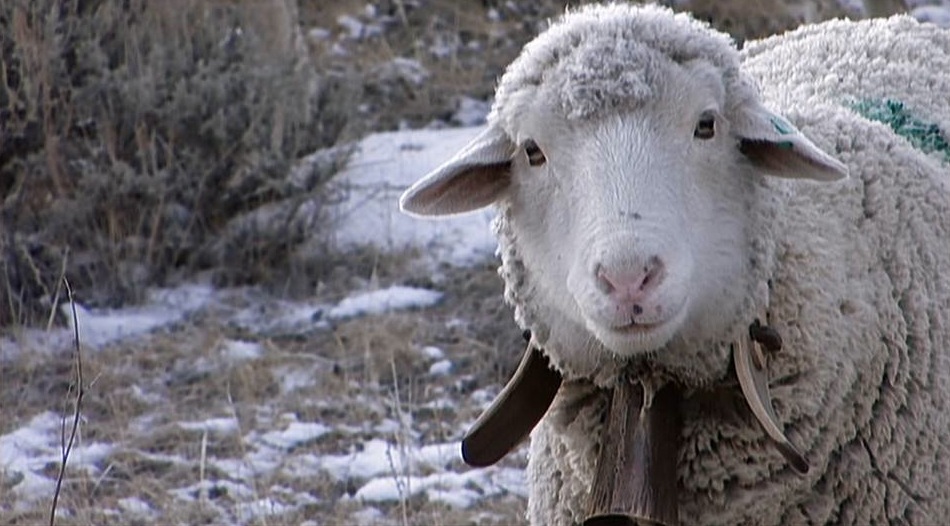Close-Up on “Sweetgrass”: Experiments in Aesthetics and Ethnography
Sweetgrass (2009) opens with a shot of a snowy Montana mountain scene, devoid of motion save for tall grasses succumbing to the wind. The following shots zero in on a rusted antique car, a metal shed or trailer, and then a large herd of sheep standing idly in the snow and staring at the cameraman, or just staring blankly as sheep seem to do. The film, directed by Ilisa Barbash and Lucien Castaing-Taylor, documents a family of Montana sheepherders who were among the last ranchers to graze their animals in the Absaroka-Beartooth Wilderness near Yellowstone National Park.Sweetgrass follows a long line of documentary films focused on cultural practices on the decline in a world of global capital and accelerated technological development. But through thoughtful cinematography and sound design, the directors avoid romanticizing the sheepherders and their business, while dutifully presenting the awesomeness of the Montana backcountry and the remarkable spectacle of 3,000 sheep.
Nearly twenty minutes passes from the wintry introduction of the sheep before the first intelligible word in the film is uttered. During this time the work of the ranch is slowly and poetically revealed, with long scenes detailing very specific tasks and activities. A gelatinous mass of sheep bleat and baa as they pour through an opening in a fence, moving as if they were a single organism. A group of farmhands are shown rapidly and unceremoniously shearing the wool off a number of annoyed creatures. Several minutes are dedicated to a single shot of a round bale of hay dragged through the farm from the back of a trailer. Without human language, and accompanied by a cacophony of animal sounds and machinery, these scenes become meditative, almost romantic and abstract.
This sensation is cut when a worker abruptly yells “Oh shit!” as he forcibly guides a sheep through a barn. Something human—something banal—immediately surfaces. Bucolic farm life is supplanted with reminders of wage labor, daily frustrations and economics. The signifiers of the daily life of the sheepherders, such as coffee cups, a microwave, and jugs of water, become ever more apparent. The rupture of romanticism is affirmed in a scene that languishes on a farmhand as he methodically yet effortlessly cuts and cauterizes the tails of lambs while casually telling a joke about brain transplants and cowboys.
The film does not, however, begin to betray the region’s stunning beauty or the cast of thousands of sheep. In fact, the sheepherders soon depart the ranch for the wilderness. Typical of the film are a number of powerful wide shots of the sheep in various locations—the enormous size of the herd and the sheep’s zombie-like stares border on the sublime.
These shots reinforce the immensity of the operation at hand and the herculean effort the herding must be to manage. And it is through these scenes that the filmmakers exemplify their pairing of close-up audio and wide shots. There is a scene in which the screen is filled with sheep jockeying for space amidst a thicket of trees; thin beams of sunlight shine through the trees illuminating morning mist as it rises above the animals. As with much of the film, the soundtrack is long stretch of ovine grunting and groaning, which is punctuated by the beeping of an unseen herdsman’s walkie-talkie and his beckoning of colleagues. Walkie-talkies and closely miked conversation invade humanless or wide landscape shots several other times.
One impressive shot looks down on the herd scattered on the slope of a green mountain speckled with trees. The sheep are nearly ant-like at this distance and the herders are not initially visible. Rustling of wind and distant baas give way to the clearly audible stream of cursing from a man who is eventually seen trying to get control of the animals. The camera zooms out and the massive herd itself is rendered almost imperceptible in the mountainous landscape. But the natural, supposedly wild, environment cannot be unlinked to the herder’s string of epithets, the commercial enterprise, and the people who lead it. The natural, animal, and human are bound closely together even when they are not all seen or heard.
Sweetgrass was one of the early projects of Harvard University’s Sensory Ethnography Lab (SEL), dedicated to exploring and advancing aesthetic approaches to ethnography and anthropology. Sweetgrass co-director Castaing-Taylor directs SEL, and also co-directed, with Véréna Paravel, the lab’s acclaimed maritime documentary Leviathan (2012). It is critical to consider these films’ dual commitments to art and ethnography, and how the two disciplines aid one another. In Sweetgrass, careful pairings of seemingly disparate audio and visual components, and the purposeful interruption of mood, are not only aesthetically gratifying and engaging, they shape the narrative, gesturing towards elements of the story that might otherwise go unseen or unheard. The film basks in the sublime and the pastoral, and yet it never lets viewers forget the modern world of which the subjects are a part. The result is a rich and nuanced ethnographic study that is captivating without being simplistic or exploitative.
